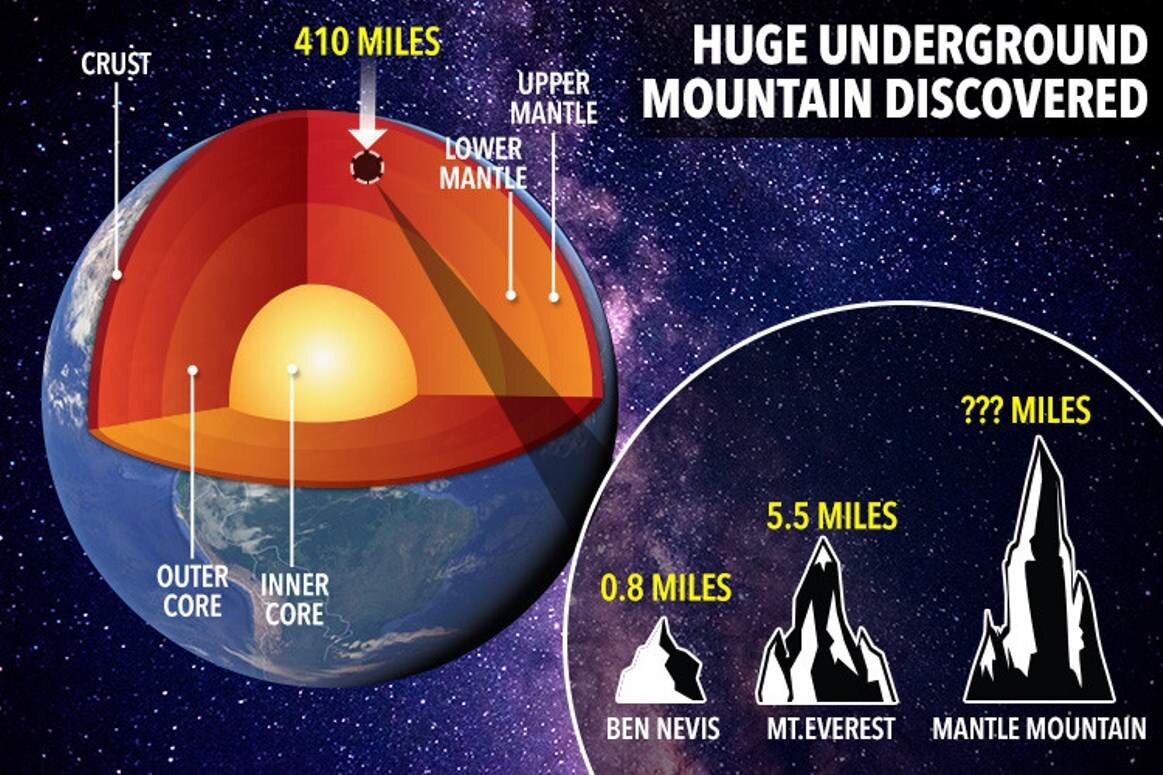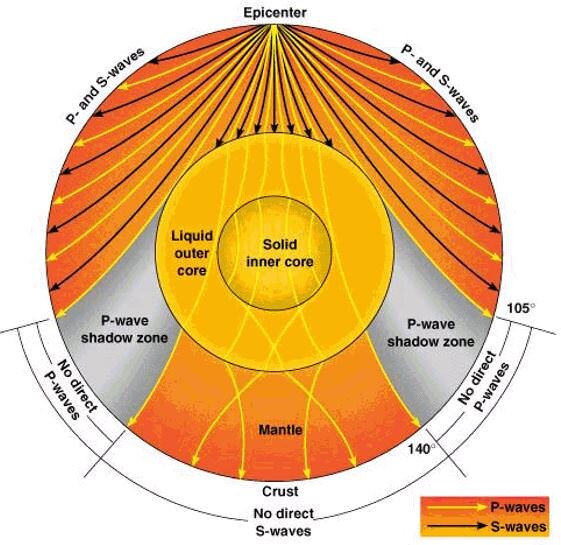Geography
Massive Mountains Discovered under Earth’s Crust
Scientists have discovered massive mountains in the Earth’s mantle.
- The mountains were located at the boundary of the outer and lower mantle at a depth of 660 km.

- Lacking a formal name for this layer, the researchers simply call it “the 660-km boundary.”
How it was Discovered?
- Scientists have used the earthquake data from the 8.2 magnitude earthquake which shook Bolivia in 1994.
- This earthquake was the second-largest deep earthquake ever recorded, with a focal point estimated at a depth of 650 kilometers.
- This earthquake was also the first big earthquake to be measured on a modern seismic network, providing researchers with unprecedented data.
- Data was gathered from earthquakes waves that travel in all directions and can travel through the core to the other side of the planet.
Findings
- From earthquake waves, the researchers came to know that the upper and lower mantle boundary at 660 km depth is rough.
- The researchers also examined a layer 410 km down, at the top of the mid-mantle “transition zone,” and the surface is not similarly rough.
Significance
- Due to technical limitations, scientists were not able to determine the height of these mountains, but there’s a chance that these mountains are bigger than anything on the surface of the Earth.
- This discovery is also important for understanding how the earth formed and continues to function.
Interior of the Earth
- The Earth has three layers: a crust, mantle, and core, which is subdivided into an inner and outer core.
Information about Interior of the Earth
- There are two sources of information for scientists about the interior of the earth: Direct and Indirect.
- Direct Sources
- Surface rock or the rocks from mining.
- Deep Ocean Drilling Projects: The deepest drill is at Kola, in the Arctic Ocean, which has reached a depth of 12 km.
- Volcanic eruptions.
- Indirect Sources
- Meteors from space.
- Gravitation, magnetic field.
- Seismic activity: Seismic activity is one of the most important sources of information about the interior of the earth.
Earthquake
- An earthquake in simple words is shaking of the earth. It is a natural event. It is caused due to the release of energy, which generates waves that travel in all directions.
- Focus and Epicenter
- The release of energy occurs along a fault. The point where the energy is released is called the focus of an earthquake.
- The energy waves traveling in different directions reach the surface of the earth. The point on the surface, nearest to the focus, is called Epicenter.
- Earthquake Waves

- Earthquake waves are basically of two types — body waves and surface waves.
- Body waves
- Body waves are generated due to the release of energy at the focus and move in all directions traveling through the body of the earth. Hence, the name body waves.
- There are two types of body waves. They are called P and S-waves.
- P-waves: P-waves move faster and are the first to arrive at the surface. These are also called primary waves.
- The P-waves are similar to sound waves. They travel through gaseous, liquid and solid materials.
- S-waves: S-waves arrive at the surface with some time lag. These are called secondary waves.
- An important fact about S-waves is that they can travel only through solid materials.
- This characteristic of the S-waves is quite important. It has helped scientists to understand the structure of the interior of the earth.
- Surface waves
- The body waves interact with the surface rocks and generate a new set of waves called surface waves.
Shadow Zones
Earthquake waves get recorded in seismographs located at far off locations. However, there exist some specific areas where the P and S waves are not reported. Such a zone is called the ‘shadow zone’.
Agriculture
Policy Bias Against Rainfed Agricultural Area
Recently a new rainfed agriculture atlas was released highlighting the policy biases that are making farming unviable for many in these areas.
- There has been negligence toward rainfed areas which is leading to lower incomes for farmers in these areas.
- Further farmers in rainfed areas are receiving 40% less of their income from agriculture in comparison to those in irrigated areas.
Key Issues
- Even though rainfed agriculture contributes to 60 percent of the value of agriculture GDP of India, there is a clear-cut bias towards irrigated areas when it comes to public investment in agriculture in the country.
- This neglect, together with unsuitable programme design, has ensured that potential of rainfed areas remains unrealized.
- In terms of procurement over the decade between 2001-02 and 2011-12, the government procured ₹5.4 lakh crore of wheat and rice. On the other hand, coarse cereals, which are grown in rainfed areas, only had ₹3,200 crore worth of procurement in the same period.
- Flagship government schemes, such as seed and fertiliser subsidies and soil health cards, are designed for irrigated areas and simply extended to rainfed farmers without taking their needs into consideration.
Way Forward
- More balanced approach is needed, to give rainfed farmers the same research and technology focus, and production support that their counterparts in irrigation areas have received over the last few decades.
- There is an urgent need to do more R&D in rainfed agriculture and bring in more policy perspective like tweaking of government schemes by considering the needs of rainfed agricultural areas.
- In the long run, cash incentives and income support like the PM-KISAN scheme announced in the interim budget 2019 are better than extensive procurement as they are inclusive in character, and doesn’t distinguish between farmers in one area or another, growing one crop or another.
- Along with income support to help farmers through the current crisis, it is now the time to design better structured interventions for the future.
- Like the ease of doing business, ease of doing farming should be done on the parameters of seeds, soil, water in rainfed areas to make agriculture attractive in the long term.
Important Facts For Prelims
Important Facts for Prelims (18th February 2019)
Punjab’s Blackbuck Under Threat
- Blackbuck is fighting for its existence at the Abohar Wildlife Sanctuary (AWS) located in the Fazilka District of Punjab which is an open sanctuary, spread across private land in several villages.
- Blackbuck's status is 'Least Concern' species (IUCN Red List) but it faces a severe threat from stray cattle, attacks by stray dogs, barbed wire and habitat fragmentation due to change in land use and cropping patterns over the past few years.
- The blackbuck was notified as the State animal of Punjab in 1989 and its presence in the State is confined to AWS due to the unique habitat of semi-arid plains consisting agricultural fields, intermittent fallow-barren lands, scattered sand dunes, sand mounds, and ridges.
Munich Security Conference
- Recently, the 55th Munich Security Conference (MSC) concluded in Germany.
- MSC is an annual conference on the international security policy that takes place in Munich, Germany since 1963.
- During the MSC 2019, India raised the issue of the Pulwama terror attack during bilateral meetings with several countries, including the US, Germany, and Russia.
- MSC is an independent venue for policymakers and experts for open and constructive discussions about the most pressing security issues of the day and of the future.
- MSC publishes the Munich Security Report, an annual digest of relevant figures, maps, and research on crucial security challenges.
Tagore Cultural Harmony Award
- Recently, the President of India has presented the Tagore Award for Cultural Harmony.
- The award was given to Shri Rajkumar Singhajit Singh ( scholar of Manipuri dance), Chhayanaut (a cultural organization of Bangladesh) and Shri Ram Sutar Vanji (a renowned sculptor) for the years 2014, 2015 & 2016 respectively.
- The Tagore Award for Cultural Harmony was instituted by the Government of India from 2012 recognizing the contributions made by Rabindranath Tagore to humanity at large with his works and ideas, as part of the Commemoration of his 150th Birth Anniversary in 2012, for promoting values of Cultural Harmony.
- The Award is open to all persons regardless of nationality, race, language, caste, creed or gender.




